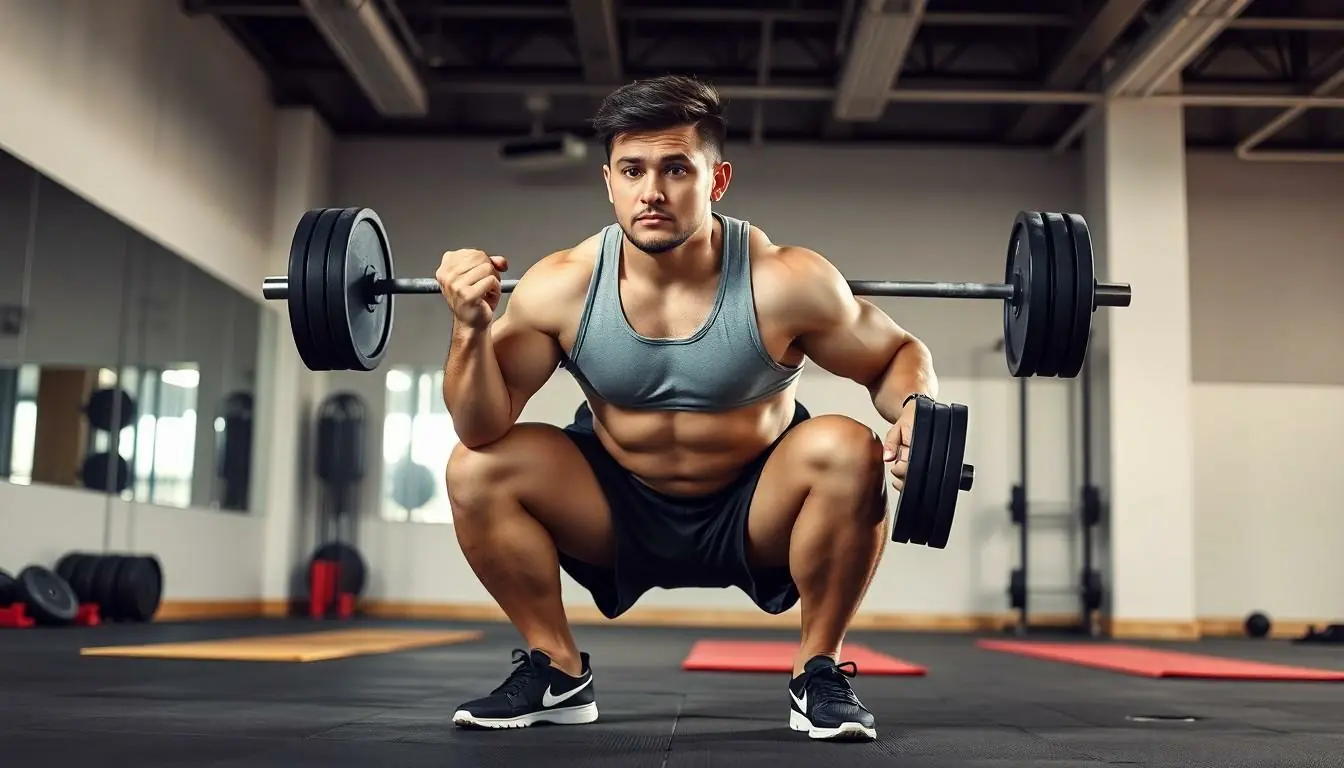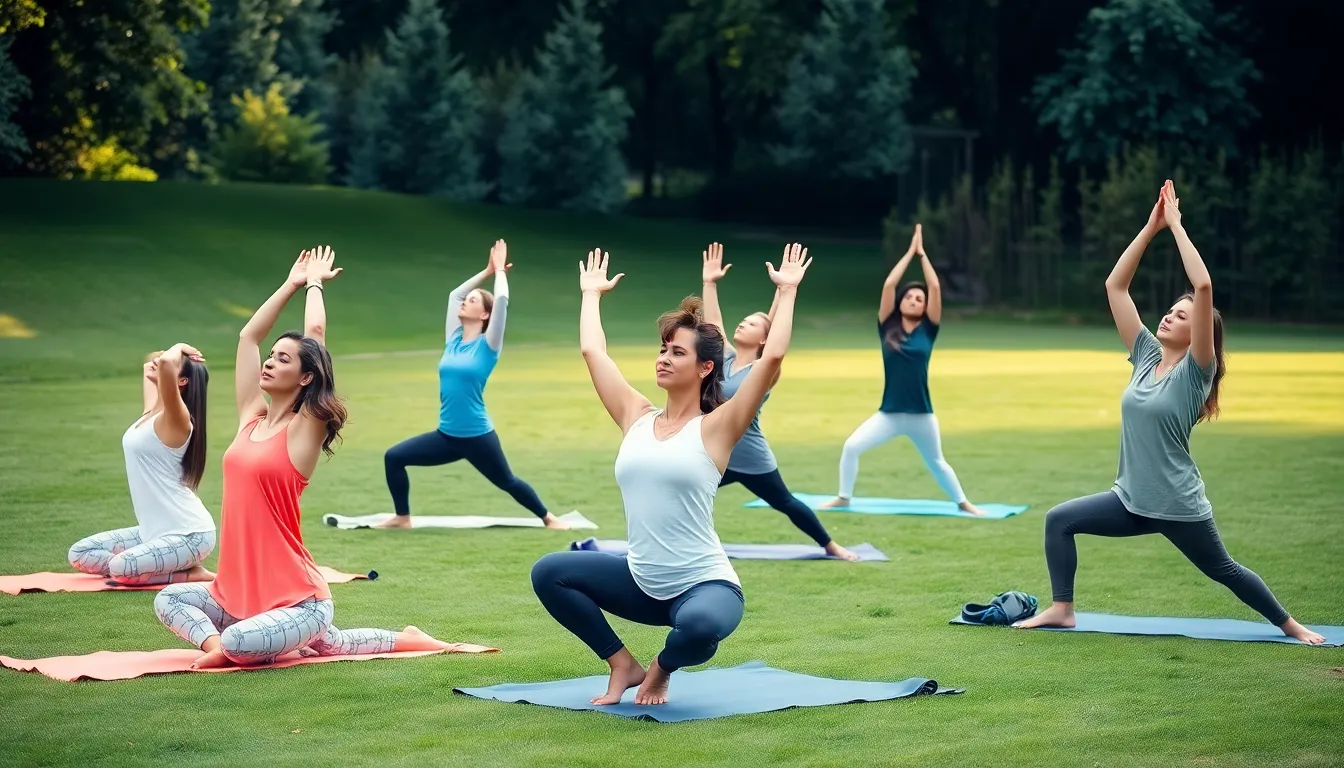If the thought of squats makes you cringe, it’s time to meet their more fabulous cousin: the sumo squat. This exercise isn’t just for those who dream of becoming a sumo wrestler; it’s for anyone looking to sculpt their legs and glutes while having a little fun. With a stance that resembles a dance move straight out of a ’90s music video, the sumo squat brings a fresh twist to your fitness routine.
Table of Contents
ToggleOverview of Sumo Squat Exercise
The sumo squat exercise targets major muscle groups such as the quadriceps, hamstrings, and glutes. A wider stance, reminiscent of traditional sumo wrestling, engages muscles more effectively than standard squats. This exercise not only builds strength but enhances flexibility and balance as well.
Performing the sumo squat requires proper form. Feet should be positioned wider than shoulder-width apart. To begin, toes point slightly outward, enabling deeper squatting. Maintaining an upright torso throughout the movement ensures safety and maximizes muscle engagement.
Incorporating sumo squats into workout routines brings variety. It’s effective for both beginners and experienced athletes. The sumo squat can easily be modified with weights like dumbbells or kettlebells, increasing intensity and further challenging muscles.
According to fitness experts, sumo squats also help improve posture. Strengthening the inner thighs, core, and lower back contributes to overall stability. Regular practice promotes joint health and can alleviate tension in surrounding areas.
A well-rounded workout might include several repetitions of sumo squats alongside other exercises. Perform two to three sets of 10 to 15 repetitions to reap maximum benefits effectively. Adding this exercise can make fitness routines more dynamic and enjoyable for those seeking diverse workout options.
Benefits of Sumo Squat Exercise

Sumo squats offer numerous advantages for those looking to enhance their fitness routines. These benefits primarily include strengthening lower body muscles and improving flexibility and range of motion.
Strengthening Lower Body Muscles
Sumo squats effectively target the quadriceps, hamstrings, glutes, and inner thighs. Engaging core muscles improves overall stability. This exercise promotes muscular endurance through repetitions. By incorporating weights, individuals can increase resistance and enhance strength gains. Fitness experts recommend performing two to three sets of 10 to 15 repetitions for optimal results. Proper form ensures maximum muscle activation and minimizes injury risk. As the body becomes accustomed to the movement, gradual increases in weight can lead to significant strength improvements.
Improving Flexibility and Range of Motion
Performing sumo squats enhances flexibility in the hips and lower back. A wider stance facilitates deeper squatting, allowing for increased depth in movement. This depth contributes to better muscle recruitment across various ranges. Enhanced flexibility tends to improve squat performance and daily activities. Regular practice can lead to greater overall mobility and reduce the likelihood of injuries. Individuals notice that their improved range of motion aids in other exercises and daily functional tasks. Incorporating this exercise into a fitness regimen can yield long-term benefits for flexibility.
Proper Form for Sumo Squat Exercise
Maintaining proper form is crucial for maximizing benefits and reducing injury risk during the sumo squat exercise. Proper alignment ensures effectiveness in targeting major muscle groups.
Common Mistakes to Avoid
Noticing common errors helps refine technique. One frequent mistake is allowing the knees to cave inward, which can strain the joints. Feet aren’t always positioned wide enough, undermining the squat’s effectiveness. Not keeping the chest lifted can lead to poor posture, transferring strain to the back. Incorrect depth during the squat can limit muscle engagement, while improper weight distribution may cause balance issues. Ensuring alignment and addressing these mistakes enhances performance.
Tips for Maintaining Correct Posture
Correct posture supports the effectiveness of the sumo squat. Start by positioning feet wider than shoulder-width apart with toes angled slightly outward. Keeping the back straight and chest proud prevents strain on the spine. Engaging the core stabilizes the body throughout the movement. As they lower themselves, individuals should keep their weight on the heels rather than the toes for better balance. Visualizing sitting back in a chair helps maintain proper depth while ensuring the knees track over the toes.
Variations of Sumo Squat Exercise
Sumo squat variations add diversity to workouts while targeting different muscle groups effectively. Exploring these variations can enhance strength, endurance, and overall fitness.
Sumo Squat with Dumbbells
Incorporating dumbbells into sumo squats increases resistance and challenges muscles further. Holding one dumbbell with both hands or a dumbbell in each hand works the upper body while engaging the lower body. Weights can be positioned in front of the body or at chest level for optimal grip. This variation intensifies the workout, pressing muscles to adapt and grow stronger. Fitness professionals recommend starting with lighter weights, gradually increasing as strength improves. It’s essential to maintain proper form, ensuring the back remains straight and the knees align with the toes.
Sumo Squat Pulses
Sumo squat pulses focus on endurance and muscle endurance, emphasizing continuous tension on the muscles. This variation involves lowering into a sumo squat and performing small, controlled pulses at the bottom position. These pulses keep the muscles engaged and intensify the workout, promoting greater results. Engaging the core and keeping the chest lifted is vital for maintaining balance and posture. Fitness experts suggest aiming for 10 to 15 pulses per set to maximize muscle engagement. Including this variation can elevate the difficulty of the exercise and accelerate strength development.
Incorporating sumo squats into a fitness routine can transform lower body workouts. This exercise not only strengthens key muscle groups but also enhances flexibility and balance. With its unique stance and variations, it keeps workouts engaging while promoting better posture and stability.
Practicing sumo squats regularly can lead to significant improvements in strength and mobility. By focusing on proper form and gradually adding weights, individuals can maximize their results and enjoy a dynamic fitness experience. Embracing the sumo squat can ultimately make fitness more enjoyable and effective for everyone.





